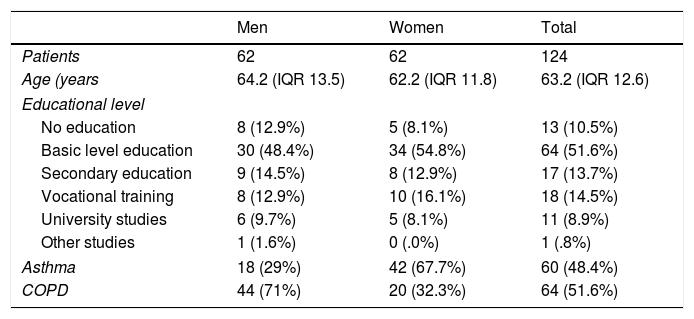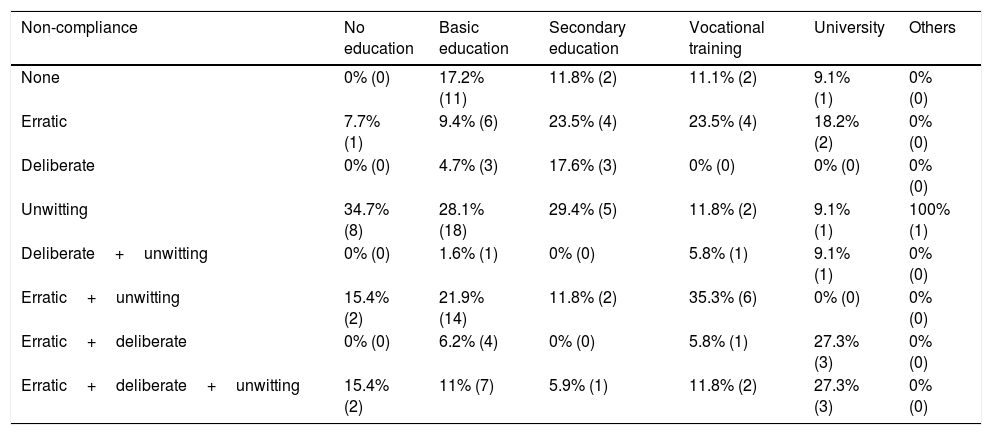To find out the degree of adherence to inhaled therapy in patients with chronic obstructive pulmonary disease (COPD) and asthma in a pulmonology clinic. To identify the type of non-compliance and the different factors affecting it.
MethodA descriptive, cross-sectional study in which 124 patients were included. Adherence was assessed using the ‘Test of Adherence to Inhalers’ (TAI) questionnaire.
ResultsA total of 62 women and 62 men were recruited and the average age was 63. Fifty-one point 6 percent of the patients had COPD, and 48.4% were asthmatics. Thirty-eight point 7 percent of the them showed high adherence, 37.9% showed intermediate adherence and 23.4%, low adherence. In terms of non-compliance, 13.7% was erratic, 4.8% was deliberate, and 28.2%, unwitting. Patients with a basic level of education had better compliance than the others (p=.05), and patients with COPD showed higher adherence than the asthmatics (p=.02). Age, gender and the trainer did not indicate significant statistical differences.
Conclusion38.7% of patients show high adherence to inhaled therapy, with a predominance of unwitting non-compliance. Patients with COPD and with a basic level of education showed higher levels of adherence. The training given by the pulmonologist and the respiratory nurse seemed to improve adherence to these treatments, although no significant differences were found.
Conocer el grado de adherencia a la terapia inhalada en pacientes con enfermedad pulmonar obstructiva crónica (EPOC) y asma en una consulta de Neumología. Identificar el tipo de incumplimiento y otros factores que influyen en el mismo.
MétodoEstudio descriptivo transversal en el que se incluyó consecutivamente a 124 pacientes. La adherencia se evaluó a través del Cuestionario Test de Adhesión a los Inhaladores (TAI).
ResultadosSe reclutó a 62 mujeres y 62 hombres, y la mediana de edad fue 63 años. El 51,6% fueron pacientes con EPOC y el 48,4% con asma. El 38,7% presentó buena adherencia, el 37,9% intermedia y el 23,4% mala. En cuanto al incumplimiento, un 13,7% fue errático, un 4,8% deliberado y un 28,2% inconsciente. Los pacientes con estudios básicos tuvieron mejor cumplimiento que los demás (p=0,05) y los pacientes con EPOC presentan mejor adherencia que los asmáticos (p=0,02). La edad, el género y el formador no mostraron diferencias estadísticas significativas.
ConclusionesEl 38,7% de los pacientes presentan una buena adherencia a la terapia inhalada, predominando el incumplimiento inconsciente. Pacientes con EPOC y con estudios básicos presentan mayores niveles de adhesión. La formación de neumólogo y enfermera de neumología parece mejorar la adherencia, aunque no se encontraron diferencias significativas.
Artículo
Comprando el artículo el PDF del mismo podrá ser descargado
Precio 19,34 €
Comprar ahora








